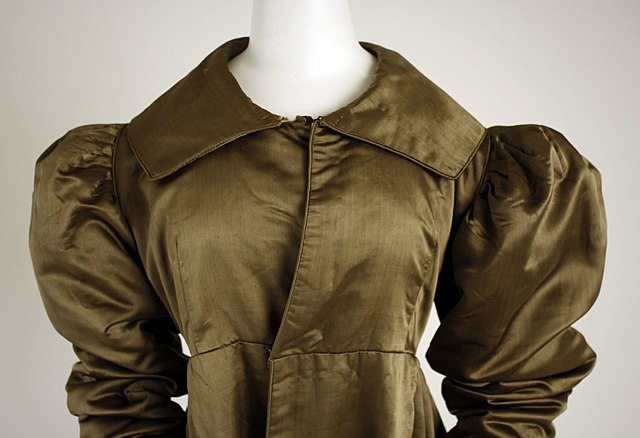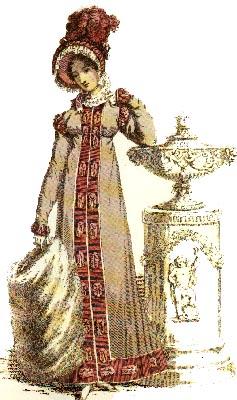Dressing for Mourning in the Regency
My mother is preparing mourning for Mrs. E. K.; she has picked her old silk pelisse to pieces, and means to have it dyed black for a gown -- a very interesting scheme, though just now a little injured by finding that it must be placed in Mr. Wren's hands, for Mr. Chambers is gone. As for Mr. Floor, he is at present rather low in our estimation. How is your blue gown? Mine is all to pieces. I think there must have been something wrong in the dye, for in places it divided with a touch. There was four shillings thrown away, to be added to my subjects of never-failing regret. Jane Austen to Cassandra Oct 7,1808
 Much of what we now assume to be hard and fast rules of 19th c. mourning were really the brought into play during the Victorian era when ettiquette books became a popular way for the newly burgeoning middle class to immitate the behaviour of their more established “betters”. To be sure, some rules applied, but printed lists similar to this one from 1875 would not have been found:
Parent or Child: Twelve Months, six in parametta with crepe trim, three months in black, three in half mourning
Sibling: Six months, three in crepe, three in black
Aunt or Uncle: Three months in black
First Cousin: Six weeks in black
How then, would the Austen’s have prepared for mourning? Their lives were continueally touched by sorrow and the question of what to wear is mentioned several times in Jane’s letters. Here, she refers to the death of her sister in law, Elizabeth Austen Knight, who passed away soon after her eleventh confinement:
Much of what we now assume to be hard and fast rules of 19th c. mourning were really the brought into play during the Victorian era when ettiquette books became a popular way for the newly burgeoning middle class to immitate the behaviour of their more established “betters”. To be sure, some rules applied, but printed lists similar to this one from 1875 would not have been found:
Parent or Child: Twelve Months, six in parametta with crepe trim, three months in black, three in half mourning
Sibling: Six months, three in crepe, three in black
Aunt or Uncle: Three months in black
First Cousin: Six weeks in black
How then, would the Austen’s have prepared for mourning? Their lives were continueally touched by sorrow and the question of what to wear is mentioned several times in Jane’s letters. Here, she refers to the death of her sister in law, Elizabeth Austen Knight, who passed away soon after her eleventh confinement:
Your parcel shall set off on Monday, and I hope the shoes will fit; Martha and I both tried them on. I shall send you such of your mourning as I think most likely to be useful, reserving for myself your stockings and half the velvet, in which selfish arrangement I know I am doing what you wish. I am to be in bombazeen and crape, according to what we are told is universal here, and which agrees with Martha's previous observation. My mourning, however, will not impoverish me, for by having my velvet pelisse fresh lined and made up, I am sure I shall have no occasion this winter for anything new of that sort. I take my cloak for the lining, and shall send yours on the chance of its doing something of the same for you, though I believe your pelisse is in better repair than mine. One Miss Baker makes my gown and the other my bonnet, which is to be silk covered with crape. Jane Austen to Cassandra Oct 15, 1808This description of what Jane already owned and what she intended to purchase probably gives a good representation of what might be in the closet of any middle class lady of moderate fortune. The crepe that she refers to was a lightweight black silk, while bombazine was a medium weight silk and wool blend. As referred to in the first quote, it was also possible to dye existing garments to a suitable shade for mourning and thereby extend your wardrobe with little expenditure. Far from being the go with anything neutral that it is today, black was a color reserved for mourning. Other colors which would have been worn during various stages of mourning were violet, lavender, and gray. These lighter colours would have been used during half-mourning—the time between the “slighting” of all-black (though white trim was acceptable) and that of resuming current fashions and colours. For a widow, this would traditionally be one year and a day from her husband’s death to 18-24 months after his death when she could resume a full social calendar. Yet so miserably had he conducted himself, that though she was at this present time (the summer of 1814) wearing black ribbons for his wife, she could not admit him to be worth thinking of again. Persuasion Husbands, brothers, fathers and sons would be expected to wear black suits as well as a black crepe armband. Their mourning would be less noticeable as black was an accepted color for men’s attire, and expected at formal events. During full mourning, the family of the deceased was expected to eschew formal entertainment such as balls, dinner parties and dances, restricting their social obligations to the necessities and church. Children and siblings need not mourn quite as deeply or as long as a spouse, but a show of respect was expected even for distant relatives. When a Royal died, the entire nation was plunged into mourning. Thrify Mrs. Austen sought to purchase material for mourning gowns before the king’s expected death in 1811, for surely prices would increase with demand.
I had just left off writing and put on my things for walking to Alton, when Anna and her friend Harriot called in their way thither, so we went together. Their business was to provide mourning against the King's death, and my mother has had a bombasin bought for her. I am not sorry to be back again, for the young ladies had a great deal to do, and without much method in doing it. Jane Austen to Cassandra June 6, 1811She need not have worried—George III would live on until 1820. Much of what we know about mourning attire is from period fashion magazines. With the high mortality rates of the time it is not impossible to imagine one spending several months of the year in mourning for some relative or royal. This plate is from The Gallery of Fashion, 1794.

 It is clear to see that while fashions changed over the following 10 years, expectations of mourning, did not. Even jewelry was expected to be toned down during mourning, with memorial pieces and those set with locks of hair from the deceased being popular choices. As the century progressed, pearls, diamonds and jet jewelry became the expected accessories to full and half mourning.This print, from The Lady's Magazine, or Entertaining Companion for the Fair Sex, Appropriated solely to their Use and Amusement, was published in 1805
Figure 1: Plain chemise dress of Italian gauze; full front, fastened in the centre with a jet broach, over a black sarcenet slip; sleeves and front trimmed with black net trimming, fastened with bugles. Leather gloves, and black jean shoes.
Figure 2: Dress of imperial lustre; short sleeves. Gloves and shoes the same as the first figure.
Buy a Regency dress, patterns and accessories at our Jane Austen Gift Shop
It is clear to see that while fashions changed over the following 10 years, expectations of mourning, did not. Even jewelry was expected to be toned down during mourning, with memorial pieces and those set with locks of hair from the deceased being popular choices. As the century progressed, pearls, diamonds and jet jewelry became the expected accessories to full and half mourning.This print, from The Lady's Magazine, or Entertaining Companion for the Fair Sex, Appropriated solely to their Use and Amusement, was published in 1805
Figure 1: Plain chemise dress of Italian gauze; full front, fastened in the centre with a jet broach, over a black sarcenet slip; sleeves and front trimmed with black net trimming, fastened with bugles. Leather gloves, and black jean shoes.
Figure 2: Dress of imperial lustre; short sleeves. Gloves and shoes the same as the first figure.
Buy a Regency dress, patterns and accessories at our Jane Austen Gift Shop
 Laura Boyle shares an avid interest in Regency Fashion. She runs Austentation, a company that specializes in custom made Regency Hats, Bonnets and Accessories.
Laura Boyle shares an avid interest in Regency Fashion. She runs Austentation, a company that specializes in custom made Regency Hats, Bonnets and Accessories.



Leave a comment
This site is protected by hCaptcha and the hCaptcha Privacy Policy and Terms of Service apply.